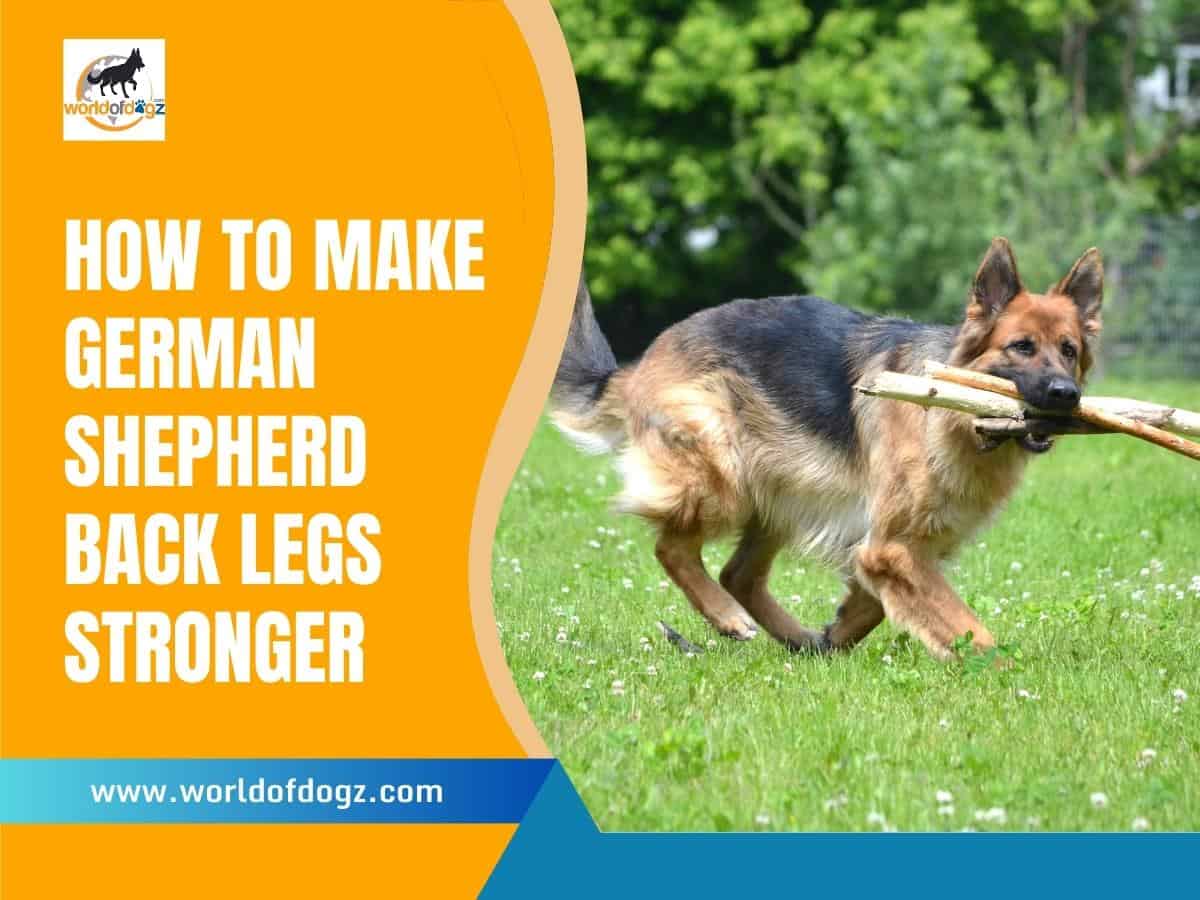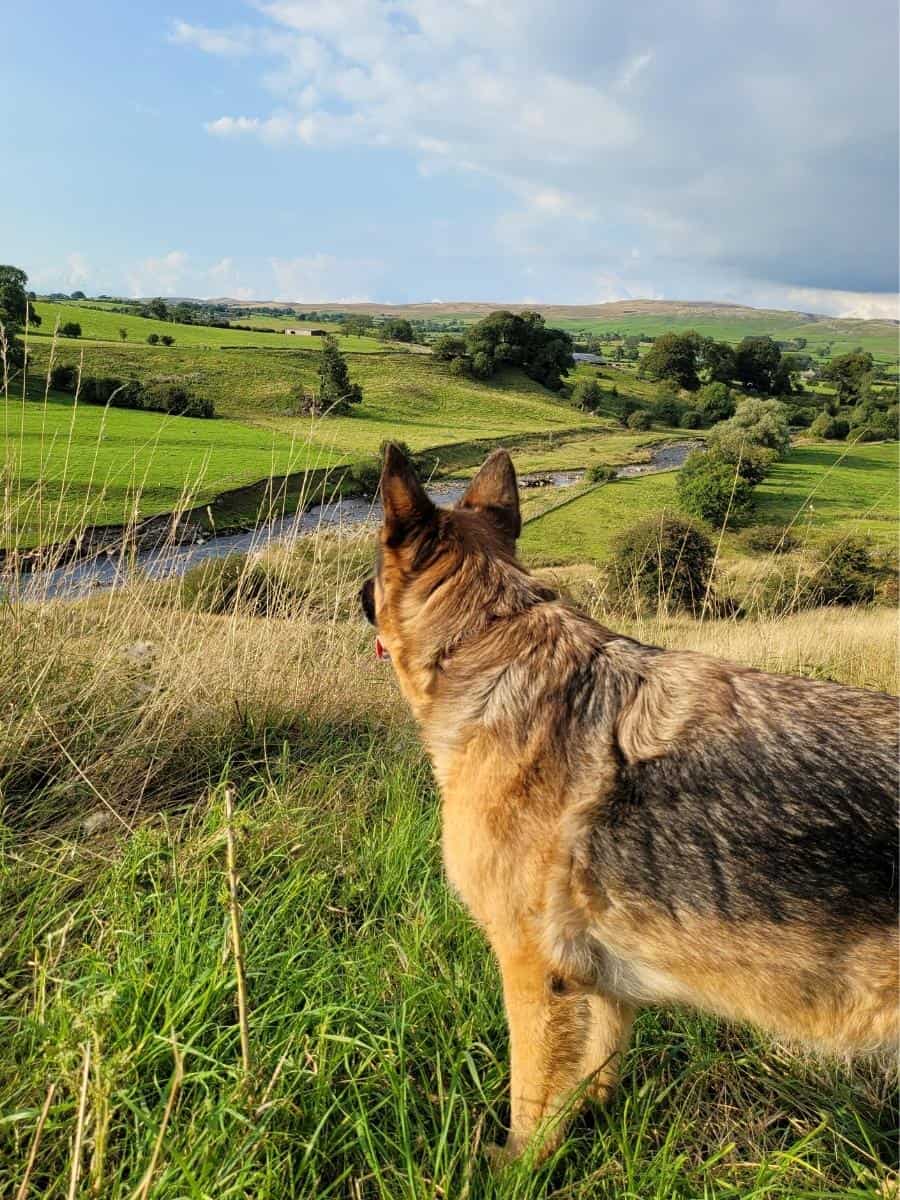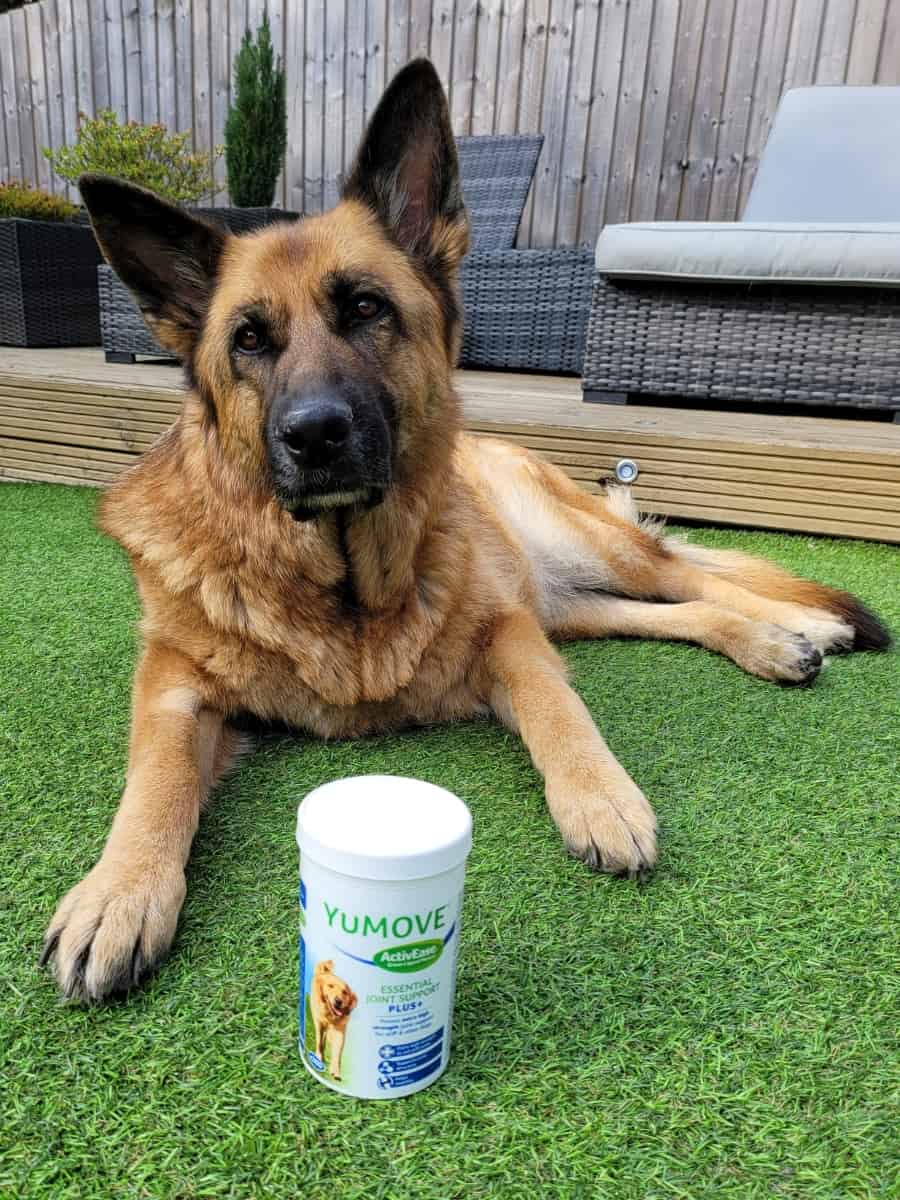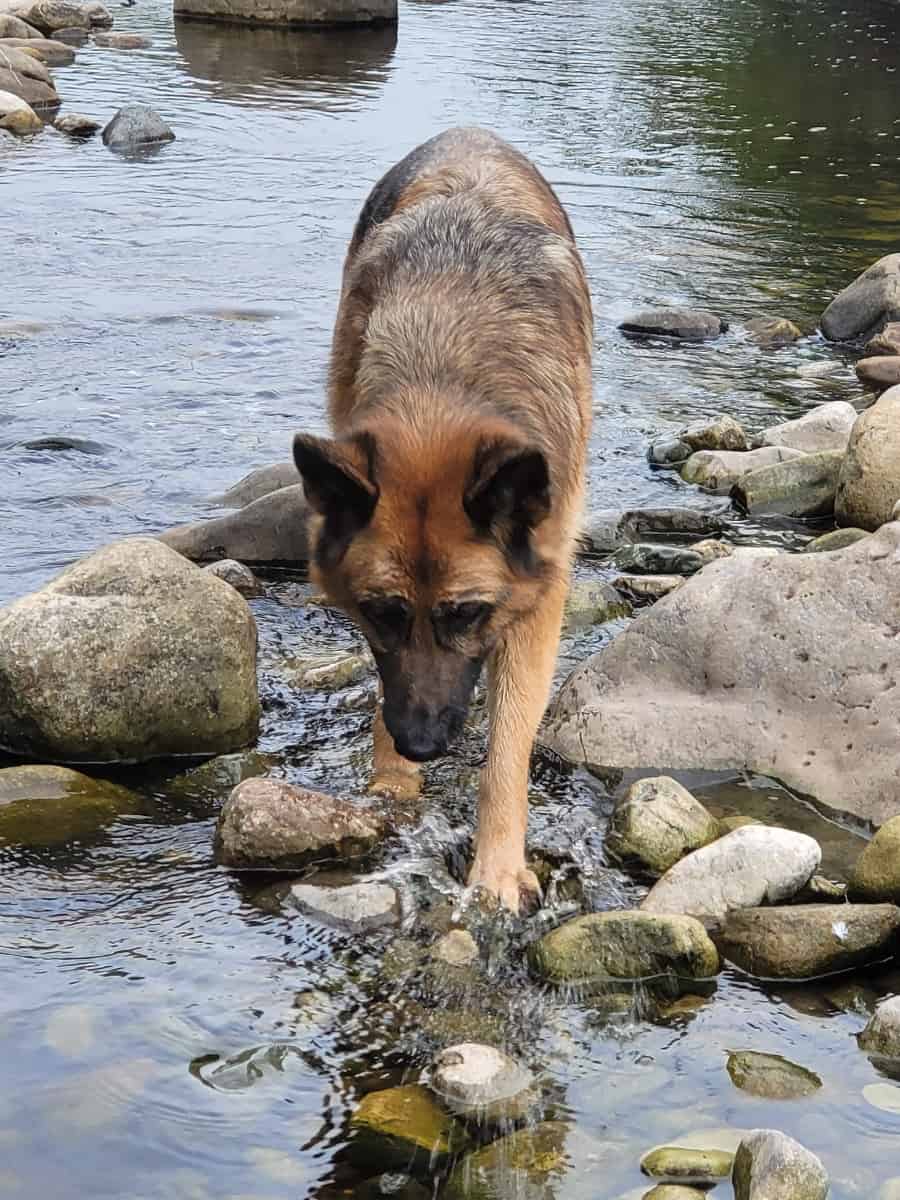Aging comes with bone and joint issues for German Shepherds and their owners. While the owners most likely know what to do to help their bones and joints stay strong, knowing how to make German Shepherd back legs stronger can be an uphill task, but not impossible.
You can make a German Shepherd’s back legs stronger by feeding him a high-quality diet with all the nutritional requirements and regularly exercising your dog. If your GSD has weak hind legs, consider hip and joint supplements and treatment for any underlying health issues.
For any first-time German Shepherd owners in the house, age is not the only reason you might need to strengthen your GSD’s hind legs. Several other reasons discussed in this article are to blame for weakened German Shepherd back legs.
We start with those causes, then proceed to the symptoms, and finally, the remedies for how to make your German Shepherd’s back legs stronger.
Let’s get right to it!

Why do German Shepherds Have Back Leg Problems?
Erect ears are not the only signature trait in German Shepherds. A unique back and hind legs posture is also part of a purebred GSD’s standard feature.
When you register your purebred German Shepherd with a national kennel club like the AKC or the (English) Kennel Club, one of the standard requirements is that your dog’s upper and lower hind thighs are well-muscled and form a correct angle.
In normal health, this angulation facilitates your German Shepherd’s forward propulsion when walking or running. Unfortunately, the same feature can work against your dog.
So, here are the two primary reasons why German Shepherds have back leg problems:
- The German Shepherd’s knee is closer to the ground. As a result, the dog’s back and hind legs can experience extra strain with daily activities, especially as your dog ages. With aging, this additional strain may turn into serious health issues.
- According to experts, German Shepherds stand and trot differently from other large breeds. This difference means unique joint loading patterns and extra hip extension. The resulting strain explains your German Shepherd’s susceptibility to musculoskeletal problems such as hip dysplasia and osteoarthritis.
So, if you have a senior German Shepherd dog like my Willow, you have to think of ways of making his hind legs stay strong.

As mentioned earlier, the story of weak German Shepherd hind legs does not end with their breed-specific angulation and aging. Several other health issues can cause your German Shepherd’s hind legs to be weak.
Below is a quick list of health problems that weaken your GSD’s hind legs:
- Genetics: As alluded to previously, German Shepherds have a genetic predisposition to musculoskeletal disorders like arthritis, degenerative myelopathy, and hip dysplasia. In fact, this predilection for bone and joint diseases is a primary cause of GSD mortality, according to a recent UK study.
- Join trauma and injuries: These result from accidents that damage or separate joints, as in the case of joint subluxations.
- Diabetes: If your German Shepherd has diabetes, he could develop muscle weakness in the hind legs and other joints due to poor glucose supply to the muscles. One of the uncommon muscle problems that come with diabetes mellitus is diabetic neuropathy. The condition can cause gradual hindlimb weakness, among other symptoms.
- Poor nutrition: Both undernutrition and overnutrition can cause musculoskeletal disorders and limb weakness in your GSD. The first because your dog lacks enough of the nutrients necessary for muscle, joint, and bone health. The second because the additional weight puts an extra strain on your GSD’s hind legs.
- Lack of exercise: Like us, a sedentary lifestyle for your German Shepherd can lead to joint stiffness and muscle loss, making your dog’s legs weaker.
While most of these issues require proper diagnosis and treatment by a veterinarian, you can prevent or delay their presentation in your German Shepherd by strengthening your dog’s hind legs.
Before I tell you how, let’s first answer how you know that your German Shepherd has weak hind legs.
Signs Your German Shepherd Has Weak Hind Legs
Whether your German Shepherd’s hind legs are weak due to age and disease-related causes or due to poor nutrition, you will notice some or all of these symptoms and signs:
- Reluctance to stand and walk: Your GSD may prefer to stay sitting or lying down most of the time. The reason is the lethargy that comes with weak hind legs.
- A wobbly effort to stand: Your dog shows an extra effort to go on his legs, similar to the struggle a newborn calf will make to stand.
- Poor coordination of the hind legs when walking: This could lead to regular slips and falls.
- Reduced hind leg muscle mass: Especially if your GSD back leg weakness is due to musculoskeletal disorders or nutritional deficiencies.
- A low carriage while walking: This means your dog walks slowly and closer to the ground in an effort to have better control of his hind legs.
- Hind legs paralysis: This is usually a last stage symptom for musculoskeletal diseases like degenerative myelopathy. At this stage, movement becomes minimal or almost impossible.
Of course, it doesn’t hurt to repeat that you should not trust your eye blindly with the symptoms and signs of German Shepherd legs. The trophy for precise diagnosis belongs to your dog’s vet.
That said, we can now proceed to the core topic of this post: How to make German Shepherd back legs stronger.
How to Make German Shepherd Back Legs Stronger
The ways to strengthen your German Shepherd’s back legs stem from the methods used to address the causes discussed above.
Below are 6 ways to make a German Shepherd’s back legs stronger.
1. Keep Your GSD in Ideal Weight with a Proper Diet
Feeding has a direct impact on dog weight. As mentioned earlier, underfeeding or overfeeding can impact your German Shepherd’s bone and joint health. That leaves us with the middle option: proper feeding.
Your German Shepherd needs a high-protein diet and the right amounts of other core nutrients to stay in a healthy weight. You can read more about the right amounts of food nutrients for your GSD in our article, How Much to Feed a German Shepherd.
So how do you know if your German Shepherd is in healthy weight?
Here’s how:
- Watch your dog from above. The waist should be well-defined and go straight across and down the sides.
- Check your dog from the side. The abdomen should tuck up well.
- Feel your dog’s ribs. The ribs should neither be protruding nor hard to feel under a lot of body fat. Instead, you should feel them without needing to press in.
This video from Hill’s Pet Nutrition will give you a visual demonstration of those steps:
If your German Shepherd has a healthy weight, he will not experience extra strain on his back and hind legs. And that will keep the hind legs strong.
2. Be Faithful to your GSD Daily Exercises
German Shepherds are high-energy dogs. They need at least an hour of exercise daily. But that exercise is not only about keeping them happy and mentally stimulated. It is also about maintaining healthy bones, muscles, and joints.
There are several exercises you can do to keep your German Shepherd’s hind legs healthy:
- Walking and jogging: Do this daily for 60-90 minutes, preferably in a morning and evening shift.
- Swimming: Swimming is a perfect exercise for strengthening your GSD’s hind legs. That’s because the water supports the back and legs, and your dog’s effort to propel in the water has a low impact on the joints and muscles.
- Occasional hikes: Taking your German Shepherd for hiking generally counts as walking. But it will have an additional advantage on your dog’s muscles because of varied terrain, like hills and descends.
- Tug of war: A tag of war game will require your German Shepherd to control and keep his front and back legs steady, which is a good game for stronger leg muscles.
- Squats: These may look easy to your eyes, but squatting strengthens your GSD’s thigh muscles.
- Catch games: A catch game makes your dog start the chase with a sprint, which works to strengthen the hind leg muscles.
3. Give Your GSD Hip and Joint Supplements
Hip and joint supplements are not a diet requirement for every dog.
However, if you suspect your German Shepherd may not be getting everything he needs for healthy bones, joints, and muscles, a boost of supplements may be opportune. Just don’t make the decision alone without talking it over with your dog’s vet.
That said, some German Shepherd dogs may necessarily require hip and joint supplements. Those dogs fall into these two categories.
- Your German Shepherd is a senior, with 7 or more years of age.
- Your GSD has been diagnosed with a musculoskeletal disorder like arthritis.
My German Shepherd has mild hip dysplasia, so my vet recommended YuMove Joint Care supplements. YuMove is scientifically proven to work in 6 weeks, which is why vets so highly recommend it. I just throw these into her food bowl every day, and she doesn’t even notice they’re there.
- Triple-action formula eases (occasional) stiffness, supporting joint structure and promoting mobility in adult dogs.
- Scientifically proven to work in 6 weeks.*
- Powered by our very own unique and sustainably sourced ActivEase Green Lipped Mussel (GLM).
- Contains Hyaluronic Acid, which is a major part of synovial fluid and part of our unique formula, helps to lubricate and cushion the joint.
- Plant based Glucosamine provides basic building blocks of cartilage helping to maintain joint structure.
- GLM is a source of Chondroitin, which helps to maintain healthy joints.
- Antioxidants Vitamins C & E help to mop up free radicals.
- YuMOVE is the UK’s no.1 vet-recommended joint supplement brand.**
- Already supporting over 2 million dogs a year globally.***
- Made in the USA with globally sourced ingredients. *YuMOVE Joint Care is scientifically proven to work in 6 weeks by an in vivo, double blind, placebo-controlled, objectively measured canine clinical study by the Royal Veterinary College UK (excludes YuMOVE for Young Dogs). **YuMOVE is the UK’s no.1 vet recommended joint supplement brand with 8 out of 10 UK veterinarians recommending YuMOVE ADVANCE 360 – Survey conducted by CM Research. November 2021 (n = 101). ***YuMOVE brand tracking study 20
Prices pulled from the Amazon Product Advertising API on:
Product prices and availability are accurate as of the date/time indicated and are subject to change. Any price and availability information displayed on [relevant Amazon Site(s), as applicable] at the time of purchase will apply to the purchase of this product.
While supplements may not cure your dog’s age and health-related joint and muscle issues, they will go a long way in managing the conditions by:
- Supporting normal mobility.
- Alleviating strain and pain.
- Managing inflammation.
- Cushioning joints from cartilage breakdown and supporting cartilage growth.
- Slowing hip and joint disease progression.

4. Get your Dog Treated for Underlying Health Conditions
If your German Shepherd has weak hind legs due to some of the health conditions mentioned earlier, the responsible thing to do is have your dog treated for the conditions.
Of course, treatment starts with a proper vet diagnosis, which may be followed with one of the following treatments depending on the condition:
- Insulin therapy for German Shepherds with Diabetes Mellitus.
- Anti-inflammatory and pain management drugs for musculoskeletal conditions.
- A support harness for GSDs struggling with poor mobility due to already weak hind legs.
- Surgery where medication is insufficient.
5. Consider Modern Treatments
With advanced vet knowledge and technology, there are modern treatments that can help your German Shepherd’s hind legs become stronger. These treatments work by alleviating pain or facilitating cartilage and muscle regeneration.
The treatments include:
- Acupuncture therapy, which helps restore the energy balance in your dog’s body, thereby promoting healing. The fine needles inserted in nerve-converging points of your dog’s body, such as the joints, send good energy (chi) to the rest of the body and stimulate anti-inflammatory and pain-reducing body substances.
- Veterinary Laser Therapy, also known as cold laser therapy, class III/IV laser therapy, or low-level laser therapy. Vets use laser therapy to manage inflammation, pain, and healing from wounds and joint injuries such as surgery and subluxation.
- Hydrotherapy, which literally means exercising in water to strengthen the muscles without straining the joints. It relaxes the muscles and joints and relieves pain from diseases or injuries. Hydrotherapy for your German Shepherd can mean swimming or other water exercises like mineral baths, saunas, or water aerobics.
- Chiropractic therapy, which is an animal care technique that corrects the misalignment of the central nervous system (CNS). Because the CNS controls all functions in your GSD’s body, its healthy functioning ensures strong legs and better mobility.
If you go for a dog chiropractor, hire one with the American Veterinary Chiropractic Association (AVCA) accreditation.
Should you decide to go for any of these therapies, you also should abide by our usual drill: talk to your vet first!

6. Protect Your German Shepherd from Injuries
Keeping your German Shepherd free of maiming injuries is important in keeping the dog in good joint and muscle health and normal mobility.
Injuries to your GSD’s hind legs may result from motor vehicle accidents or the strain caused by exercises.
You can avoid these injuries by:
- Ensuring you accompany your German Shepherd every time he is out of the house and preferably on a leash.
- Considering your GSD’s age, health, and muscle resistance before you engage your dog in straining exercises.
FAQs
Before you leave, these two FAQs on how to make German Shepherd back legs stronger will interest you.
How Can I Get My German Shepherd to Gain Muscle on His Back Legs?
You can help your German Shepherd gain muscle on his hind legs by providing a healthy, high-protein diet with the right ingredients for other nutritional needs. Exercising your dog daily for 60-90 minutes and ensuring your dog stays healthy and gets the needed daily rest is equally important.
What Can I Give my German Shepherd to Strengthen His Hind Legs?
Consistently feeding your German Shepherd a high-quality diet with all the nutritional requirements is good enough to keep your dog’s hind legs strong. However, if your dog’s back legs are already weak, you can consider a hip and joint supplement, but only after consultation with your vet. Good nutrition and supplementation should go hand in hand with regular exercise.
Concluding Thought
A healthy German Shepherd has fun running or playing energy-spending games. To do that, however, your dog must be in good joint and muscle health, especially in his hind legs.
If you worry about how to make German Shepherd back legs stronger, this article has just resolved your puzzle. We hope you keep your dog healthy and exercising.
Related Posts You May Like:






